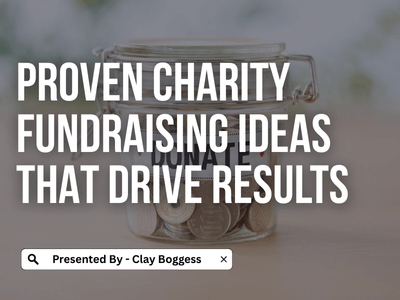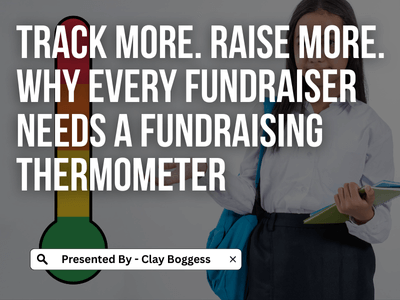
Learn how to build a donor list that endures.
As you know, nonprofits use fundraising events to raise money, strengthen current donor relationships, and expand donor bases. Aside from building trust with current donors, expanding reach by honing in on new donors is critical for maintaining or increasing an organization's donation rate.
We don't need to tell you how vital donors are, so we'll skip your big question: how do you find new donors to steward?
Our answer? Look to your fundraising event attendees!
Whether you run a peer-to-peer fundraiser and aren't directly in touch with your supporters or you're organizing a charity auction. You can mingle with your supporters for hours on end and follow these easy ways to use event fundraising to identify and retain new donors:
- Conduct prospect research before your event.
- Study previous giving patterns.
- Send thank-you's.
- Reconnect with supporters on social media.
- Give supporters the next steps.
- Review your reports and analytics.
Many nonprofits turn to event fundraising software to make managing their events less chaotic so they have more time to chat and build relationships with supporters during the event. Using software allows your event to turn uncommitted supporters into engaged and involved donors.
Read on to learn how to identify and retain new donors from your events!

1. Conduct prospect research before your event.
Use your registration forms for even more!
To steward them properly, you must know who's coming to your event before they enter the venue.
Establishing connections with these supporters before your event will help transition them from supporter to donor organically. You'll want to take the names from your RSVP list and conduct prospect research.
If possible, you'll want to know the following information about every potential attendee:
- Age
- Location
- Hobbies
- Income
- Philanthropic history
- Giving patterns
- Political giving
- Business affiliations
- Real estate ownership
- Stock holdings
You'll be able to gather all this with the help of your registration list and the details you receive from it.
You can personalize your outreach if you know these individuals through and through. For example, a philanthropic track record indicates future giving and gives you a great way to connect with this supporter. Use an opportunity to speak with donors about how their philanthropic interests might relate to your cause during your event.
You'll want to ensure you're approaching each supporter for donations in the best way possible to see the best results—throughout your event and in general practice.
For example, if 22-year-old Richard makes $30,000 a year, your best practice might be to ask him for a small donation after the event and via social media. That way, he can decide whether or not to donate with some knowledge of your nonprofit's mission in mind.
But for 57-year-old seasoned donor Christina, who makes $75,000 a year, you might send an email newsletter reminding you of your upcoming event and a prominently displayed donation button.
The bottom line: Optimizing your outreach to potential new donors will begin with a thorough prospect reach before your event so you have a general sense of who will attend.

2. Study previous giving patterns.
A supporter's previous giving patterns will help you determine the likelihood of which they will donate to your organization at your event. From your prospect research, you'll be able to decipher which attendees' giving patterns show the potential to become great donors to your organization.
When looking at your supporters' donation history, answer these questions:
- Have they been given to nonprofit organizations before?
- Do they give to more than one nonprofit regularly?
- Do they give to nonprofits with cases similar to yours?
- Have they attended any of your previous events?
- What is the size of their average donation?
Suppose an event attendee has only ever given to nonprofits specializing in animal rights, and you're a nonprofit focusing on cancer survivors. In that case, the match may not be worth pursuing.
However, remember that your best donors may be suitable in front of you, so if you find an attendee who regularly gives to nonprofits that emphasize health and your organization focuses on global health, you may have found a new donor to retain!
The bottom line: Previous giving patterns will give you specific insight you wouldn't otherwise have access to. This information can help you narrow your search and focus on the correct event attendees to become new donors.

3. Send thank-yous.
After your event or any donation, expressing gratitude to your supporters is necessary to retain your donors. They want to know you appreciate not only their monetary gifts but their moral support, so to turn supporters into donors, you can even send thank-you's out to supporters just for attending your events.
The most important part of your thank-you is making it feel authentic. Always thank each donor with their preferred name and title, regardless of the donation amount. (Remember: even the smallest donations are gifts from your donors to you!)
Remember, new donors who get a personalized acknowledgment right after their first contribution are likelier to give again! That makes sense.
Here are some methods of communication you can use to thank your donors:
- Letter
- Phone call
- Social media shout out
You can send handwritten thank-you letters in the mail; however, some supporters may prefer emails to mail or even tweets to emails.
You'll want to look at each supporter's profile to consider their preferred method of communication. As mentioned, a 22-year-old may respond better to a social media shout, while a 57-year-old is probably more familiar with email.
The bottom line: Never mass-email donors a generic thank-you after your fundraising event. Look at the donor profiles you created in step one and use the data to personalize your gratitude so each thank-you sounds authentic and grateful.

4. Reconnect with supporters through social media.
Speaking of tweets, social media is a friendly reminder that your work isn't done just because your fundraising event has concluded and your thank-you's have been dropped in the mail! It's easy to identify new donors, but it's not that easy to retain them.
This is where your effort will make the difference, and your up-to-date communication methods can prove your professionalism and make your organization more amiable.
As the quickest and most convenient platform, social media will be your best friend when it comes to continuing interaction with donors both during and after your event.
To increase your online presence and benefit from it, you should have social media profiles on several platforms so your donors can interact with you on whichever platform they prefer.
Remember to tailor your approach to match your donors' online presence. In other words, if your donors are younger, Instagram and Snapchat might be great platforms to capitalize on. Still, if your nonprofit typically caters to 50+ year-olds, Snapchat will most likely be a massive waste of your resources.
After your event, whether it's Twitter, Facebook, Snapchat, or Instagram, you can be a master of communication with them all.
Through your timelines and dashboards, you'll want to update your supporters on progress with projects and furthering your cause. With the continuous updating of feeds, there's no excuse to avoid upkeep on your profiles.
The bottom line: Using social media to interact with and update your supporters even after your event will give your organization an approachable, professional reputation. Be on top of popular technology and preferred platforms because if you drop off your supporters' radars, the fight to get them back will be nearly impossible.

5. Give supporters the next steps.
Asking supporters to give money immediately or right after they've already given to your event will seem harsh and, quite frankly, greedy—they're not ATMs!
Instead, give them more opportunities to get involved with your organization (because it's crucial to your nonprofit's success and building a solid relationship with supporters!).
Offer supporters the option to sign up for your email newsletter. Whether in person on an old-fashioned signup sheet or virtually through an online form, signing up for your newsletter will give supporters regular updates on your organization.
These progress reports can inspire your supporters to become more actively involved in your nonprofit and become part of the momentum that pushes you toward your goals.
This leads us to another great way to involve your supporters: volunteer opportunities!
See if any new supporters (and loyal donors!) are interested in volunteering at your next fundraising event. If you need help thinking of ideas for another event, check out Wild Apricot's list of 200 fundraising ideas.
Remember to inform individuals about your event at least 12-9 weeks in advance (maybe even earlier, depending on the type of fundraiser), which you can do with your handy email newsletter!
Offering registration for your newsletter is crucial because it will help turn supporters into volunteers, and in the long run, turning volunteers into donors is easier than you might think. Volunteering opportunities give supporters an insight into your nonprofit, so they'll understand where your passion and values lie. And when they see the dedication to your cause, how can they resist donating to make your goals a reality?
The bottom line: Remember that your donors are not money trees but individuals who can get involved! Give them the following steps to becoming more engaged with your organization to build strong donor relationships.

6. Review your reports and analytics.
Your last step is a measure of your success. Use your event fundraising software to customize your reports so you'll see how well you're identifying and retaining new donors.
After a fundraising event, you should be able to say you've gained more donors and raised more money than you had before.
Because of your analytics, you'll also be able to decipher areas that need improvement. To get a better feel of how your asking and outreach strategies are received, you can always send out surveys to your supporters.
Asking for their opinions can also strengthen relationships, proving you value their judgments. Shy away from language like, "Our organization needs your input," and follow a similar tone to, "Your input is greatly appreciated." Put the importance on your donors, not your organization, to avoid an approach that may come off as selfish.
The bottom line: Measuring your success is easiest through your software's reports and analytics features, which can tell exactly where you performed well and where to focus for your next event.
_____________________________________________________________________________________________________________________________________________________________
Now that you have these six tips to help identify and retain donors from your fundraising events, you should never have a problem raising funds or building strong donor relationships again. Happy stewarding!
Guest Author Bio
Lomesh Shah has over 25 years of experience in international corporate leadership with a strong emphasis on marketing technology and data management systems. Lomesh has worked with small to mid-size businesses, privately-held companies and Fortune 500 corporations in various capacities; from sales and marketing to overseeing automation and re-engineering of processes and operations.
As CEO of Fundly, Lomesh spends much of his time immersed in the nonprofit industry both as an industry leader, speaker, and in service to several organizations as a board member and volunteer. Outside of the industry, Lomesh is a technology junkie and will give anyone willing to listen an assessment of the latest trends in anything from espresso makers and mobile gadgets to electric cars and wind power.



